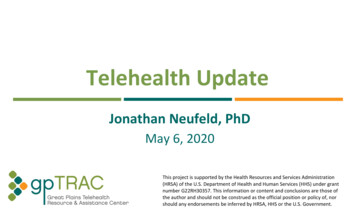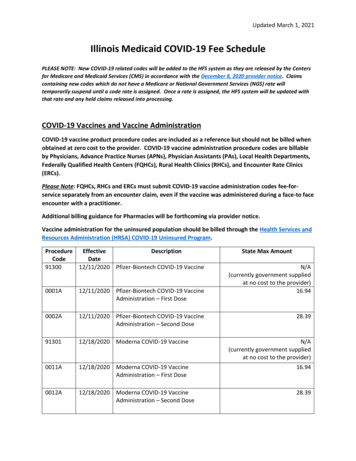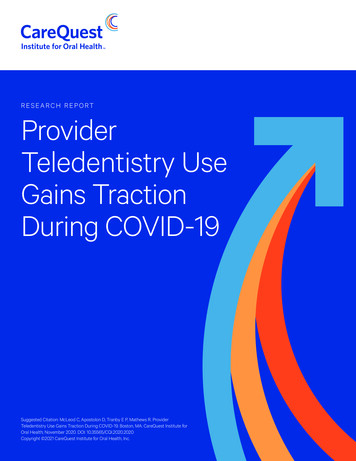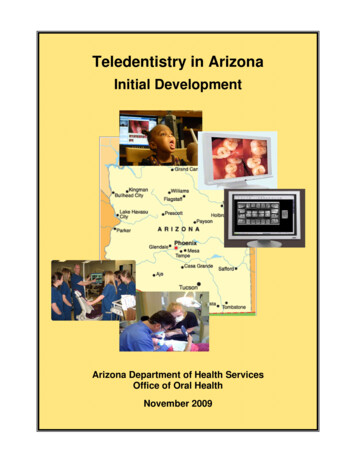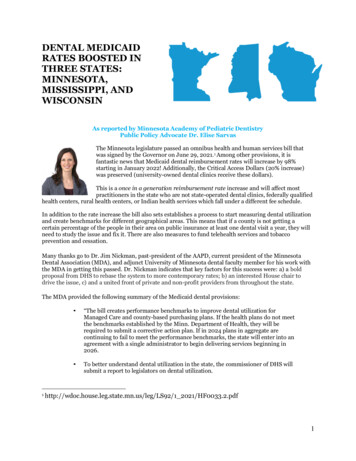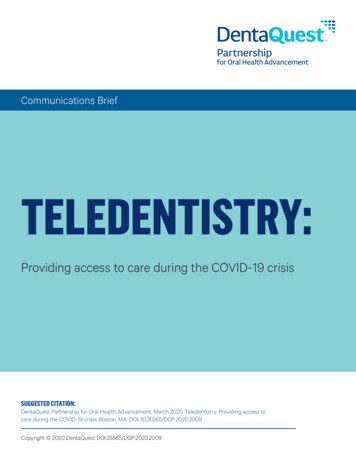
Transcription
Communications BriefTELEDENTISTRY:Providing access to care during the COVID-19 crisisSUGGESTED CITATION:DentaQuest Partnership for Oral Health Advancement. March 2020. Teledentistry: Providing access tocare during the COVID-19 crisis. Boston, MA. DOI: 10.35565/DQP.2020.2009Copyright 2020 DentaQuest DOI:35565/DQP.2020.2009
TELEDENTISTRYMODALITIESLive video(synchronous)This is two-way,“real-time” interaction between ahealth provider and a patient, theircaregiver or another provider.Store-and-forward(asynchronous)Patient care can befacilitated by transmitting photos,video, X-rays, or other recordedinformation via a secure electronicsystem to a health provider whoreviews the information and/orupdates a patient’s treatment plan.Remote patientmonitoring (RPM)This telehealth modeallows personal health or medicaldata to be collected from anindividual in a different location,allowing a health provider to monitorblood pressure or another vital signor condition.Mobile health(mHealth)Smartphones or othermobile devices can be used for manypurposes. One example is an appallowing people to test the pH oftheir saliva, which affects their risk oftooth decay.As coronavirus (COVID-19) keeps millions ofadults and children at home, federal healthofficials have urgently promoted telehealthas a way to connect Medicare and Medicaidpatients with the care they need. Officialsrecognized that services provided throughtelehealth would help to free up medicalclinics and hospital emergency department(EDs) for patients with COVID-19 or othertruly urgent conditions while at the same timeenabling seniors, the medically-compromisedand other vulnerable populations to remainsafely at home. In a crisis, dental providers canuse telehealth to consult with patients, triagetheir needs, and offer limited urgent services,deterring those with serious dental conditionsfrom seeking care in EDs.This pandemic gives states a unique opportunity to build a moreaccessible and connected system that is sustainable even after theimmediate crisis subsides. Teledentistry can connect patients andproviders in different physical locations, as well as enable differentproviders who treat the same patients to share information. Teledentistryis the provision of patient care or education using one of four forms oftechnology: synchronous, asynchronous, remote patient monitoring, andmHealth. (For more details, read the new white paper by the DentaQuestPartnership for Oral Health Advancement.)Teledentistry: Providing access to care during the COVID-19 crisis2
PERSISTENT BARRIERSTO CAREMORE THANEven outside of crises, many Americans aren’t getting the dental care they need.More than 56 million Americans live in areas with a shortage of dental professionals.Dental access is a concern in rural communities, but people living in urban orsuburban areas, including seniors with limited mobility and others with complexmedical issues also encounter barriers to care in traditional settings. When peopledon’t receive dental care, both oral health and overall health can easily deteriorate.Despite research showing the ability of telehealth to manage chronic diseases andreduce mortality rates, a variety of barriers remain, especially for teledentistry. Alack of access to care can lead to untreated tooth decay or other infections, leavingpeople with no viable options other than visiting hospital EDs, where treatment iscostly and can disrupt more urgent needs in a time of crisis.56 MILLIONAMERICANSin shortage areasONLY 6 STATES HAVEMOST OF THE DENTISTSneeded to eliminate shortagesReducing unnecessary EDvisits is critical, especiallyin states with olderpopulations at greater riskof mortality from COVID-19.Each year in the United States, there are approximately 2 million hospital ED visitsfor nontraumatic dental problems, and most of these visits were for oral healthneeds that could have been addressed at a dental office, including care deliveredthrough teledentistry. In Florida, there were more than 489,000 visits to hospitalEDs for dental conditions over a three-year period, and roughly four in 10 visitswere reimbursed by its Medicaid program. Given the strong oral health-diabetesconnection, it’s worth noting that diabetes-related complications were the 12thmost expensive condition billed to Medicaid programs during 2013. Reducingunnecessary ED visits is critical, especially in states with older populations atgreater risk of mortality from COVID-19.ORAL HEALTH OVERALL HEALTHGrowing research connects oral health with other chronic health conditions.Here are some examples:Diabetes:Stroke:Osteoporosis:Aspiration Pneumonia:Treating periodontal(gum) disease helpspeople with diabetesmanage their bloodsugar levels.Studies reveal the riskof stroke is linked toboth tooth loss andperiodontal disease.Research shows thatosteoporosis andperiodontal disease areassociated and could berisk factors for each other.Improving oral hygieneamong medically-fragileseniors was linked to raisingtheir survival rate fromaspiration pneumonia.Teledentistry: Providing access to care during the COVID-19 crisis3
WHAT STATES CAN DOGovernors in Illinois, New Jersey, Texas and other states have issued orders inrecent weeks to expand telehealth. However, even before COVID-19 reached ournation, there were excellent reasons for all states to encourage telehealth. Thesetechnology tools can help prevent disease and, equally important, assist Americansin managing chronic conditions given the connection of many chronic diseasesto oral health. By making permanent changes to laws and policies that shapeteledentistry, states would be more nimble and better prepared for similar crisesin the future, as well as being able to address needs that may be prolonged withthe current COVID-19 situation. States can leverage the Coronavirus Aid, Reliefand Economic Security (CARES) Act that Congress recently approved and whichincludes multiple provisions explicitly aimed at promoting telehealth.Besides improving health and holding down costs, teledentistry and othertelehealth initiatives offer the potential for creating and preserving jobs. In recentyears, many rural hospitals have closed. Hospitals are major employers in ruralareas, and their financial stability might be enhanced by serving as a hub forteledentistry programs.As of 2019, nearly all states have a definition for telehealth or telemedicine,and live video services are reimbursed by Medicaid in all states. Althoughmost states are supporting some form of telehealth, progress in the area ofteledentistry is lagging behind other health disciplines. State policymakers maynot be aware of the ways in which their laws or regulations unintentionallymake it tougher for teledentistry to improve access.Methodology for the Teledentistry State MapTeledentistry Measure (Low to High)15(A rank of 5 is the most supportive)Data dataset from three interactive maps onthe Scope of Practice Policy website, designedby the National Conference of State Legislature(NCSL) and the Association of State andTerritorial Health Officials (ASTHO), wasused to gauge state-based environmentson Teledentistry based on 3 parameters:1) dental hygienists with direct access,2) recognition of dental therapists as amember of the oral health team, and3) states that allow the practice of Teledentistry.Information provided in the maps was used toevaluate each state on these parameters on ascale of 1-5, with 1 representing low environmentand 5 being high environment.States Ranked by Policy Environments that Support TeledentistryTeledentistry: Providing access to care during the COVID-19 crisis4
There are four key areas that state policymakers should address:Dental workforce: In addition to dentists, dental hygienists and other staff haveimportant roles to play for teledentistry to reach its full potential. Unfortunately,most State Practice Acts do not permit all members of the dental workforceto practice at the highest level of their skills and training. Accordingly, StatePractice Acts should enable care to be provided in community settings bynon-dentists while having appropriate regulations to ensure oversight, instead ofimposing direct supervision rules.Reimbursement policies: Both public and private insurers should providereimbursement for teledentistry delivered through live video or a store-andforward mechanism, and states should update their Medicaid reimbursementrules accordingly. Moreover, policymakers, benefits companies and professionalorganizations should seek reimbursement that gives teledentistry parity withtraditional dental care and does not discriminate based on the type of dentalprovider that rendered the service.Policymakers and otherstakeholders should bevigilant in ensuring thatdental information andteledentistry are recognizedas essential elements.Legal clarity: States can expand teledentistry by bringing clarity to legalissues such as liability coverage for dental providers, getting “credentialed,”data security and rules of compliance with the Health Insurance Portabilityand Accountability Act (HIPAA). States also should recognize that teledentistry programs may struggle to meet requirements for making patient recordsavailable on request, and rules like this should not be permitted to obstructbasic types of information-sharing that can limit teledentistry to only preventiveservices.Sharing patient information: Experts and leading stakeholders are workingtogether to make electronic health records (EHRs) interoperable—meaningthey are shareable. State health commissioners and Medicaid directors shouldsupport efforts to achieve interoperability and mandate that certified health ITproducts adopt the dental exchange standard. Policymakers and other stakeholders should be vigilant in ensuring that dental information and teledentistryare recognized as essential elements as health information systems and vendorsadapt to this federal rule. Finally, states should explore financial incentives orsubsidies to enable dental care organizations and care teams to improve orupgrade technology and provide needed training as infrastructure evolves.Teledentistry: Providing access to care during the COVID-19 crisis5
NOW IS THE TIME FORACTIONCreating a supportive climate for teledentistry would help statesensure that a pandemic or another crisis does not cut off people’saccess to care for many days or weeks. Telehealth can enablemany people to receive services or education in compliance withsocial-distancing guidelines and averting visits to hospital EDsthat are already overwhelmed. Bringing care to where people arecan reach millions of children and adults who are not receivingservices currently in the oral health system, rather than leavingpeople with no alternative but visiting EDs, where care is costlyand where hospitals need to free space for treating urgentlyill patients. Dental benefit companies are moving quickly toensure coverage and awareness of telehealth options amongtheir members.For a deeper examination of teledentistry’s promiseand what states can do to address the barriers it faces,READ DENTAQUEST’SFAST-TRACK TO TELEDENTISTRYWHITE PAPER.Teledentistry: Providing access to care during the COVID-19 crisis6
The DentaQuest Partnership for OralHealth Advancement is laser-focused ontransforming our broken health care systemto enable better health through oral health.Through strategic grantmaking, researchand care improvement initiatives we drivemeaningful change at the local, state andnational levels. The DentaQuest Partnershipis a nonprofit part of DentaQuest, a leadingU.S. oral health enterprise with a missionto improve the oral health of all through anall-in approach we call Preventistry .FIND OUT MORE ATdentaquestpartnership.orgDentaQuest465 Medford StreetBoston, MA 02129-1454
national levels. The DentaQuest Partnership is a nonprofit part of DentaQuest, a leading U.S. oral health enterprise with a mission to improve the oral health of all through an all-in approach we call Preventistry . FIND OUT MORE AT dentaquestpartnership.org DentaQuest 465 Medford Street Boston, MA 02129-1454
